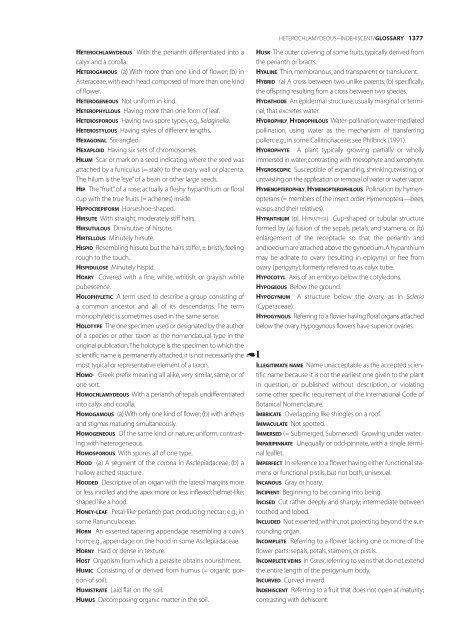Appendices & Glossary - Botanical Research Institute of Texas
Appendices & Glossary - Botanical Research Institute of Texas
Appendices & Glossary - Botanical Research Institute of Texas
Create successful ePaper yourself
Turn your PDF publications into a flip-book with our unique Google optimized e-Paper software.
HETEROCHLAMYDEOUS With the perianth differentiated into a<br />
calyx and a corolla.<br />
HETEROGAMOUS (a) With more than one kind <strong>of</strong> flower; (b) in<br />
Asteraceae, with each head composed <strong>of</strong> more than one kind<br />
<strong>of</strong> flower.<br />
HETEROGENEOUS Not uniform in kind.<br />
HETEROPHYLLOUS Having more than one form <strong>of</strong> leaf.<br />
HETEROSPOROUS Having two spore types; e.g., Selaginella.<br />
HETEROSTYLOUS Having styles <strong>of</strong> different lengths.<br />
HEXAGONAL Six-angled.<br />
HEXAPLOID Having six sets <strong>of</strong> chromosomes.<br />
HILUM Scar or mark on a seed indicating where the seed was<br />
attached by a funiculus (= stalk) to the ovary wall or placenta.<br />
The hilum is the “eye”<strong>of</strong> a bean or other large seeds.<br />
HIP The “fruit” <strong>of</strong> a rose; actually a fleshy hypanthium or floral<br />
cup with the true fruits (= achenes) inside.<br />
HIPPOCREPIFORM Horseshoe-shaped.<br />
HIRSUTE With straight, moderately stiff hairs.<br />
HIRSUTULOUS Diminutive <strong>of</strong> hirsute.<br />
HIRTELLOUS Minutely hirsute.<br />
HISPID Resembling hirsute but the hairs stiffer, ± bristly, feeling<br />
rough to the touch.<br />
HISPIDULOSE Minutely hispid.<br />
HOARY Covered with a fine, white, whitish, or grayish white<br />
pubescence.<br />
HOLOPHYLETIC A term used to describe a group consisting <strong>of</strong><br />
a common ancestor and all <strong>of</strong> its descendants. The term<br />
monophyletic is sometimes used in the same sense.<br />
HOLOTYPE The one specimen used or designated by the author<br />
<strong>of</strong> a species or other taxon as the nomenclatural type in the<br />
original publication.The holotype is the specimen to which the<br />
scientific name is permanently attached;it is not necessarily the<br />
most typical or representative element <strong>of</strong> a taxon.<br />
HOMO- Greek prefix meaning all alike, very similar, same, or <strong>of</strong><br />
one sort.<br />
HOMOCHLAMYDEOUS With a perianth <strong>of</strong> tepals undifferentiated<br />
into calyx and corolla.<br />
HOMOGAMOUS (a) With only one kind <strong>of</strong> flower; (b) with anthers<br />
and stigmas maturing simultaneously.<br />
HOMOGENEOUS Of the same kind or nature; uniform; contrasting<br />
with heterogeneous.<br />
HOMOSPOROUS With spores all <strong>of</strong> one type.<br />
HOOD (a) A segment <strong>of</strong> the corona in Asclepiadaceae; (b) a<br />
hollow arched structure.<br />
HOODED Descriptive <strong>of</strong> an organ with the lateral margins more<br />
or less inrolled and the apex more or less inflexed; helmet-like;<br />
shaped like a hood.<br />
HONEY-LEAF Petal-like perianth part producing nectar; e.g., in<br />
some Ranunculaceae.<br />
HORN An exserted tapering appendage resembling a cow’s<br />
horn; e.g., appendage on the hood in some Asclepiadaceae.<br />
HORNY Hard or dense in texture.<br />
HOST Organism from which a parasite obtains nourishment.<br />
HUMIC Consisting <strong>of</strong> or derived from humus (= organic portion<br />
<strong>of</strong> soil).<br />
HUMISTRATE Laid flat on the soil.<br />
HUMUS Decomposing organic matter in the soil.<br />
HETEROCHLAMYDEOUS–INDEHISCENT/GLOSSARY 1377<br />
HUSK The outer covering <strong>of</strong> some fruits, typically derived from<br />
the perianth or bracts.<br />
HYALINE Thin, membranous, and transparent or translucent.<br />
HYBRID (a) A cross between two unlike parents; (b) specifically,<br />
the <strong>of</strong>fspring resulting from a cross between two species.<br />
HYDATHODE An epidermal structure, usually marginal or terminal,<br />
that excretes water.<br />
HYDROPHILY, HYDROPHILOUS Water-pollination;water-mediated<br />
pollination; using water as the mechanism <strong>of</strong> transferring<br />
pollen; e.g., in some Callitrichaceae; see Philbrick (1991).<br />
HYDROPHYTE A plant typically growing partially or wholly<br />
immersed in water; contrasting with mesophyte and xerophyte.<br />
HYGROSCOPIC Susceptible <strong>of</strong> expanding, shrinking, twisting, or<br />
untwisting on the application or removal <strong>of</strong> water or water vapor.<br />
HYMENOPTEROPHILY, HYMENOPTEROPHILOUS Pollination by hymenopterans<br />
(= members <strong>of</strong> the insect order Hymenoptera—bees,<br />
wasps, and their relatives).<br />
HYPANTHIUM (pl. HYPANTHIA) Cup-shaped or tubular structure<br />
formed by (a) fusion <strong>of</strong> the sepals, petals, and stamens; or (b)<br />
enlargement <strong>of</strong> the receptacle so that the perianth and<br />
androecium are attached above the gynoecium.A hypanthium<br />
may be adnate to ovary (resulting in epigyny) or free from<br />
ovary (perigyny); formerly referred to as calyx tube.<br />
HYPOCOTYL Axis <strong>of</strong> an embryo below the cotyledons.<br />
HYPOGEOUS Below the ground.<br />
HYPOGYNIUM A structure below the ovary, as in Scleria<br />
(Cyperaceae).<br />
HYPOGYNOUS Referring to a flower having floral organs attached<br />
below the ovary. Hypogynous flowers have superior ovaries.<br />
I<br />
A<br />
ILLEGITIMATE NAME Name unacceptable as the accepted scientific<br />
name because it is not the earliest one given to the plant<br />
in question, or published without description, or violating<br />
some other specific requirement <strong>of</strong> the International Code <strong>of</strong><br />
<strong>Botanical</strong> Nomenclature.<br />
IMBRICATE Overlapping like shingles on a ro<strong>of</strong>.<br />
IMMACULATE Not spotted.<br />
IMMERSED (= Submerged, Submersed) Growing under water.<br />
IMPARIPINNATE Unequally or odd-pinnate, with a single terminal<br />
leaflet.<br />
IMPERFECT In reference to a flower having either functional stamens<br />
or functional pistils, but not both; unisexual.<br />
INCANOUS Gray or hoary.<br />
INCIPIENT Beginning to be; coming into being.<br />
INCISED Cut rather deeply and sharply; intermediate between<br />
toothed and lobed.<br />
INCLUDED Not exserted; within; not projecting beyond the surrounding<br />
organ.<br />
INCOMPLETE Referring to a flower lacking one or more <strong>of</strong> the<br />
flower parts: sepals, petals, stamens, or pistils.<br />
INCOMPLETE VEINS In Carex,referring to veins that do not extend<br />
the entire length <strong>of</strong> the perigynium body.<br />
INCURVED Curved inward.<br />
INDEHISCENT Referring to a fruit that does not open at maturity;<br />
contrasting with dehiscent.
















